Students can access the CBSE Sample Papers for Class 10 Science with Solutions and marking scheme Set 1 will help students in understanding the difficulty level of the exam.
CBSE Sample Papers for Class 10 Science Set 1 with Solutions
Time: 3 Hours
Maximum Marks: 80
General Instructions:
(i) This question paper consists of 39 questions in 5 sections.
(ii) All questions are compulsory. However, an internal choice is provided in some questions. A student is expected to attempt only one of these questions.
(iii) Section A consists of 20 objective type questions carrying1 mark each.
(iv) Section B consists of 6 Very Short questions carrying 02 marks each. Answers to these questions should be in the range of 30 to 50 words.
(v) Section C consists of 7 Short Answer type questions carrying 03 marks each. Answers to these questions should be in the range of 50 to 80 words.
(vi) Section D consists of 3 Long Answer type questions carrying 05 marks each. Answer to these questions should be in the range of 80 to 120 words.
(vii) Section E consists of 3 source-based/case-based units of assessment of04 marks each with sub-parts.
Section – A(20 Marks)
Select and write the most appropriate option out of the four options given for each of the questions 1 – 20. There is no negative mark for incorrect response.
Question 1.
Identify the product which represents the solid state in the given reaction.
(A) Barium chloride
(B) Barium sulphate
(C) Sodium chloride
(D) Sodium sulphate
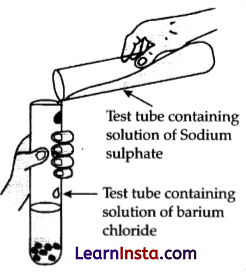
Answer:
(B) Barium sulphate
Detailed Answer:
On mixing a solution of barium chloride with sodium sulphate, a white precipitate of barium sulphate is formed.
Na2SO4 (aq) + BaCl2 (aq) → BaSO4 (s) + 2NaCl (aq)
Question 2.
The colour of the solution observed after 30 min of placing zinc metal in copper sulphate solution is
(a) blue
(b) colourless
(c) dirty green
(d) reddish brown
Answer:
(b) colourless
Zinc being more reactive than copper displaces it from copper sulphate solution and forms a colourless solution of zinc sulphate.
Question 3.
Mild non-corrosive basic salt is
(A) Ca(OH)2
(B) NaCl
(C) NaOH
(D) NaHCO3
Answer:
NaHCO3
Detailed Answer:
Mild non-corrosive basic salt is sodium hydrogen carbonate that is baking soda. Its pH is 8.3 and can be used to neutralize an acid.
![]()
Question 4.
On adding dilute sulphuric acid to a test tube containing a metal X, a colourless gas is produced when a burning match stick is brought near it. Which of the following correctly represents metal X?
(a) Sodium
(b) Zinc
(c) Copper
(d) Silver
Answer:
(a) Sodium
The metal X is sodium as on reacting with dilute H2SO4 it releases hydrogen gas which burns when a match stick is brought near to it. Note Zinc also reacts with dil.H2SO4 to give H2 gas but at a slower rate as compared to Na.
Question 5.
Which one of the following correctly represents Sodium oxide?

Answer:
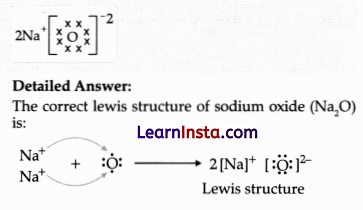
Question 6.
An element with atomic number _______ will form a basic oxide.
(a) 7 (2, 5)
(b) 17 (2, 8, 7)
(c) 14 (2, 8, 4)
(d) 11 (2, 8, 1)
Answer:
(d) 11 (2, 8, 1)
The oxides of metal are basic. Thus, among the given options, an element with atomic number 11 will form a basic oxide.
Question 7.
An element ‘M’ has 50% of the electrons filled in the 3“ shell as in the 2″ shell. The atomic number of ‘M’ is:
(A) 10
(B) 12
(C) 14
(D) 18
Answer:
(C) 14
Detailed Answer:
Atomic no. of Si is 14 and its electronic configuration: 2, 8, 4. Silicon has 50% of the electrons filled in 3rd shell as in the 2nd shell.
![]()
Question 8.
Generally, food is broken and absorbed within the body of organisms. In which of the following organisms, is it done outside the body?
(a) Amoeba
(b) Mushroom
(c) Paramecium
(d) Lice
Answer:
(b) Mushroom
Question 9.
Receptors are usually located in sense organs. Gustatory receptors are present in
(A) tongue
(B) nose
(C) eye
(D) ear
Answer:
(A) tongue
Detailed Answer:
The gustatory receptors which detect taste are present in the tongue.
Question 10.
A farmer wants to grow banana plants genetically similar enough to the plants already available in his field. Which one of the following methods would you suggest for this purpose?
(a) Regeneration
(b) Budding
(c) Vegetative propagation
(d) Sexual reproduction
Answer:
(c) Vegetative propagation
Question 11.
Height of a plant is regulated by:
(A) DNA which is directly influenced by growth hormone.
(B) Genes which regulate the proteins directly.
(C) Growth hormones under the influence of the enzymes coded by a gene.
(D) Growth hormones directly under the influence a gene.
Answer:
(C) Growth hormones under the influence of the enzymes coded by a gene.
Detailed Answer:
Height of the plant is regulated by growth hormones under the influence of the enzymes coded by the gene. The quantity ofgrowth hormones produced by a plant depends upon the efficiency of the concerned enzyme. Efficient enzymes produce a greater quantity of the hormone due to which the height of the plant increases. However, if the enzymes are less efficient, a smaller quantity of hormone is produced leading to a stunting of the plant.
Question 12.
A sportsman, after a long break from his routine exercise, suffered muscular cramps during a heavy exercise session. This happened due to
(a) lack of carbon dioxide and formation of pyruvate
(b) presence of oxygen and formation of ethanol
(c) lack of oxygen and formation of lactic acid
(d) lack of oxygen and formation of carbon dioxide
Answer:
(c) lack of oxygen and formation of lactic acid
![]()
Question 13.
An object is placed in front of a convex mirror. Its image is formed:
(A) at a distance equal to the object distance in front of the mirror.
(B) at twice the distance of the object in front of the mirror.
(C) half the distance of the object in front of the mirror.
(D) behind the mirror and it’s position varies according to the object distance.
Answer:
(D) behind the mirror and it’s position varies according to the object distance.
Detailed Answer:
When an objed is placed in front of a convex mirror, its image is always formed at the back of the mirror (virtual image) as shown in the figure. The nature of the image formed by the convex mirror does not depend on the distance of the objed from the mirror. These images are always virtual, smaller than the objed and situated behind the mirror.
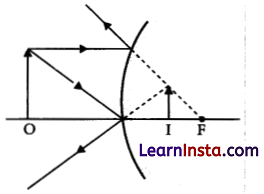
Question 14.
When light enters the atmosphere, it strikes extremely fine particles, which deflect the rays of light in all possible directions. This is due to
(a) reflection of light
(b) atmospheric refraction
(c) scattering of light
(d) dispersion of light
Answer:
(c) scattering of light
This phenomenon is due to the scattering of light.
Question 15.
In 1987, an agreement was formulated by the United Nations Environment Programme (UNEP) to freeze the production of “X” to prevent depletion of “Y”. “X” and “Y” respectively referred here are:
(A) Ozone; CFCs
(B) CFCs; rays UV
(C) CFCs; Ozone
(D) UV rays; Diatomic oxygen.
Answer:
(C) CFCs; Ozone
Detailed Answer:
The Montreal Protocol, finalized in 1987, is a global agreement formulated by the United Nations Environment Programme (UNEP) to freeze the production of CFCs to prevent the depletion of ozone.
Question 16.
Which of the following features relates to biodegradable substances?
(a) Broken down by biological processes
(b) Remain inert
(c) Persist in the environment for a long time
(d) May harm the ecosystem
Answer:
(a) Broken down by biological processes
![]()
Question No. 17 to 20 consist of two statements – Assertion (A) and Reason (R). Answer these questions by selecting the appropriate option given below:
(A) Both A and R are true, and R is the correct explanation of A.
(B) Both A and R are true, and R is not the correct explanation of A.
(C) A is true but R is false.
(D) A is false but R is true.
Question 17:
Assertion: Rusting of Iron is endothermic.
Reason: As the reaction is slow, the release of heat is barely evident.
Answer:
(D) Assertion is false but Reason is true
Detailed Answer:
The reaction between iron and moist air that produces rust is an exothermic process and generates lots of heat. This reaction is so slow that the liberation of heat is barely evident.
Question 18.
Assertion (A): The probability of survival of an organism produced through sexual reproduction is more than that of an organism produced through asexual mode.
Reason (R): Variations provide advantages to individuals for survival.
Answer:
(a) Both (A) and (R) are true and (R) is the correct explanation of (A).
Question 19.
Assertion: A compass needle is placed near a current-carrying wire. The deflection of the compass needle decreases when the magnitude of the current in the wire is increased.
Reason: The strength of a magnetic field at a point near the conductor increases on increasing the current.
Answer:
(D) Assertion is false but Reason is true
Detailed Answer:
The Magnetic field of the current-carrying conductor is directly proportional to the current flowing through it. The deflection in the needle decreases as the magnetic field is inversely proportional to the perpendicular distance from the wire. The strength of magnetic field is always proportional to the magnitude of current flowing. Hence, when the current increases, the magnetic field also increases.
Question 20.
Assertion (A): Biodegradable substances result in the formation of compost and natural replenishment.
Reason (R): It is due to the breakdown of complex inorganic substances into simple organic substances.
Answer:
(c) (A) is true but (R) is false
Reason can be corrected as During compost formation, complex organic substances are broken down into simple inorganic substances that go into the soil and are used by the plants.
Section -B(12 Marks)
(Q. no. 21 to 26 are very short answer questions.)
Question 21.
Dil. HCl is added to Zn granules.” How will you prove that chemical change has taken place here? Support your response with two arguments.
Answer:
Response with any of the given two arguments.
- Bubbles, of gas/ Evolution of gas
- Change in colour (Zn – Silvery grey to black)
- Change in temperature
Detailed Answer:
Four visual dues indicate that a chemical reaction is likely occurring:
- A gas is produced during the reaction.
- A color change occurs during the reaction.
- A solid product called a precipitate is produced in the reaction.
- Change in temperature
The reaction of zinc with hydrochloric add is as follows:
Zn (s) + 2HCl (aq) → ZnCl2 (aq) + H2 (g)
To prove that a chemical reaction has occurred:
(i) Hydrogen gas is produced during the reaction: When dilute hydrochloric add is added to granulated zinc placed in a test tube, zinc metal is converted to zinc chloride and hydrogen gas with bubbles is evolved in the reaction. The evolved hydrogen gas is colourless and odourless. A colourless and odourless gas evolved with bubbles is an indication of a chemical reaction
(ii) Change in colour from silvery grey to black: After the reaction of zinc and dilute HCl, the colour of zinc changes from grey to white because it forms a compound. The unreaded zinc however will remain the same in colour. Hence, the change in colour of ZnCl2 also determines the occurrence of a chemical reaction.
(iii) temperature change: Take zinc granules in a conical flask and add hydrochloric acid to it and observe. We see that the mixture produces zinc chloride and the temperature of the conical flask is increasing. The change in temperature of the solution signifies a chemical reaction. Temperature change is another observation that determines the chemical reaction.
![]()
Question 22.
State the post-fertilization changes that lead to fruit formation in plants.
Answer:
- After fertilization, the zygote divides to form an embryo within the ovule,
- The fertilized ovule forms a seed that is enclosed in a protective covering called the seed coat.
- As the seed grows further, the other floral parts such as petals, sepals stamens, style, and stigma may fall off.
- This leads to the growth of the ovary which enlarges and ripens to form a fruit.
Question 23.
What is the purpose of making urine in the human body? Name the organs that stores and releases the urine.
Answer:
To filter out nitrogenous waste products like and uric add from the blood in humans.
Organ for storage: Urinary Bladder
Organ for release: Urethra
OR
Why do arteries have thick and elastic walls whereas veins have valves?
Answer:
The blood emerges from the heart under high pressure and flows through arteries. Hence to bear this pressure the arteries have thick elastic walls. Veins have valves to ensure that the blood flows in one direction only.
Question 24.
The refractive indices of the three media are given below.
| Medium | Refractive Index |
| A | 1.6 |
| B | 1.8 |
| C | 1.5 |
A ray of light is travelling from A to B and another ray is travelling from B to C.
(i) In which of the two cases, the refracted ray bends towards the normal?
(ii) In which case, does the speed of light increase in the second medium?
Give reasons for your answer.
Answer:
(i) When light travels from an optically rarer medium to an optically denser medium, it moves towards the normal. Since nB > nA, hence the light ray will bend towards the normal on passing from medium A to B.
(ii) The speed of light will increase, when the light travels from B to C. Since, nC < nB and v = c/n, the speed of light ray will increase in the second medium.
Question 25.
A piece of wire of resistance R is cut into three equal parts. These parts are then connected in parallel. If the equivalent resistance of this parallel combination is R1, what is the value of the ratio R1: R?
Answer:
Resistance of each part is R/3 Ω (as resistance is proportional to the length of the wire.)
\(\frac{1}{R_1}=\frac{3}{R}+\frac{3}{R}+\frac{3}{R}=\frac{9}{R}\)
∴ R1 = \(\frac{R}{9}\) ∴ \(\frac{R_1}{R}=\frac{1}{9}\)
OR
Refer to the image given below and state how the magnetic field pattern indicates regions where the magnetic field is stronger outside the magnet. What happens to the magnetic field when the current in the circuit is reversed?
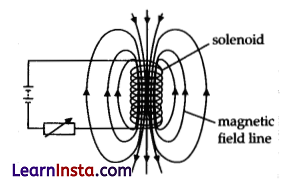
Answer:
The magnetic field strength is more in the region where the field lines are crowded. This means the field strength is maximum near the poles and it reduces as we go away from the poles. The direction of the magnetic field is also reversed.
![]()
Question 26.
Study the food chain given below and answer the questions that follow.
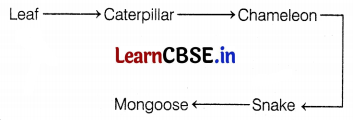
(i) If the amount of energy available at the third trophic level is 100 J, then how much energy will be available at the producer level? Justify your answer.
(ii) Is it possible to have 2 more trophic levels in this food chain just before the fourth trophic level? Justify your answer.
Answer:
(i) According to the 10% law, only 10% energy is available for the next trophic level, Therefore, 10000 J energy will be available at the producer level.
(ii) No, the energy will be greatly lost at each step and very little usable energy will remain after four trophic levels.
Section -C(21 Marks)
(Quo. 27 to 33 are short answer questions.)
Question 27.
The given reaction shows one of the processes to extract the metals like Iron and Manganese.
MnO2 (s) + Al(s) → Mn(l) + Al2O3 (s) + Heat
(a) Give reason why the above reaction is known as a thermite reaction.
(b) Identify the substance oxidised and reduced in the above reaction.
(c) Give a reason why Aluminium is preferably used in thermite reactions.
Answer:
(a) The above reaction is known as a thermite reaction as the reaction is highly exothermic.
The metal (Mn/Fe) obtained will be in molten/ liquid state.
(b) Substance oxidised- Al (s) Substance reduced- MnO2 (s)
(c) Aluminium is preferably used in thermite reactions as it is placed above Fe and Mn in reactivity series of metals. (OR) Al is more reactive than Fe/ Mn
Question 28.
An element M with electronic configuration 2, 8, 3 combines separately with Cl–, \(\mathrm{SO}_4^{2-}\) anions. Write the chemical formulae of the compounds formed. Predict with the suitable reason the nature of the bond formed by element M in general. How will the electrical conductivity of the compounds formed vary concerning M?
Or
A reddish-brown metal X when heated in air, gives a black compound Y, which when heated in the presence of H2 gas gives X back. X is refined by the process of electrolysis; this refined form of X is used in electrical wiring. Identify X and Y. Draw a well-labeled diagram to represent the process of refining X.
Answer:
The electronic configuration of M = 2, 8, 3
M on combining separately with Cl– and \(\mathrm{SO}_4^{2-}\) form MCl3 and M2(SO4)3

M in general forms an ionic bond. It can acquire a stable configuration of neon (2, 8) by losing its three valence electrons to form M3+ cation.
The compounds formed will conduct electricity in the molten state but not in the solid state.
Or
The brown metal X is copper (Cu). When heated with air, it gives CuO (Y). The reaction involved is
2Cu + O2 → 2CuO
X is acquired back by reacting with H2.
CuO + H2 → Cu + H2O
The diagram to represent the process of refining X is as follows.
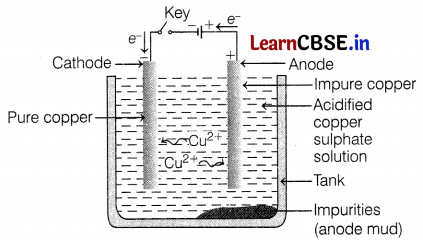
Question 29.
We are advised to take iodised salt in our diet by doctors. Justify it’s importance in our body.
Answer:
Iodine is essential for the synthesis of thyroxin 33. hormone.
Thyroxin regulates carbohydrate, protein and fat metabolism in the body.
Thyroxin provide best balance for growth in the body.
Question 30.
What is the probability of a girl or a boy being born into a family? Justify your answer.
Answer:
There is a 50% probability that a girl may be born and a 50% probability that a boy may be born in a family. It can be explained as,
- Humans have 22 pairs of autosomes and one pair of sex chromosomes.
- All females have a perfect pair of sex chromosomes XX, whereas males have a mismatched pair of sex chromosomes XY, in which one is a normal chromosome and the other is a short Y chromosome.
- A child receives one chromosome from the mother which is essentially X-chromosome.
- A child who inherits an X-chromosome from a father will be a girl and one who inherits a Y-chromosome will be a boy.
![]()
Question 31.
(a) Explain why the refractive index of any material concerning air is always greater.
(b) In the figure given below, a light ray travels from air into the semi-circular plastic block. Give a reason why the ray does not deviate at the semi-circular boundary of the plastic block.
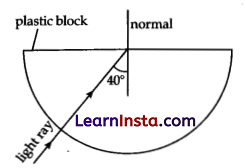
(b) Complete the ray diagram of the above scenario when the light ray comes out of the plastic block from the top flat end.
Answer:
(i) The refractive index of a medium concerning air is given by
\(\frac{\text { Speed of light in air }}{\text { Speed of light in the medium }}\)
Since speed of light in the medium is always less than the speed of light in air, hence the above ratio is always greater than 1.
(ii) The ray of light is undergoing normal incidence at the air-plastic block interface. And for normal incidence there is no deviation.
(iii)
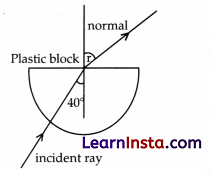
(Credit arrows, refracted ray moving away from normal)
Question 32.
(i) State the law that explains the heating effect of current concerning the measurable properties in an electrical circuit.
(ii) List the factors on which the resistance of a conductor depends.
Answer:
(i) Joule’s law of heating states that the heat dissipated across a resistor is directly proportional to
- The square of current flowing through it.
- The resistance of the conductor.
- Time of flow of current, as H = i2Rt.
(ii) Resistance of a conductor depends on R = \(\frac{\rho L}{A}\)
- Length of conductor
- Area of cross-section
- Resistivity of conductor
Question 33.
Anannya responded to the question: Why do electrical appliances with metallic bodies are connected to the mains through a three-pin plug, whereas an electric bulb can be connected with a two-pin plug?
She wrote: Three-pin connections reduce heating of connecting wires.
(a) Is her answer correct or incorrect? Justify.
(b) What is the function of a fuse in a domestic circuit?
Answer:
(i) Anannya’s answer is wrong. Electrical appliances with metallic bodies need an earth wire which provides a low resistance conducting path to the flow of current, in case there is an accidental leakage of current through the conducting body of the appliances.
(ii) An electrical fuse is a safety device that operates to protect against the overflow of current in an electrical circuit. An important component of an electrical fuse is a metal wire or strip that melts when excess current flows through it.
Section – D(15 Marks)
(Quno. 34 to 36 are long answer questions.)
Question 34.
(i) Rehmat classified the reaction between methane and chlorine in the presence of sunlight as a substitution reaction. Support Rehmat’s view with suitable justification and illustrate the reaction with the help of a balanced chemical equation.
(ii) Chlorine gas was prepared using electrolysis of brine solution. Write the chemical equation to represent the change. Identify the other products formed in the process and give one application of each.
Or
Raina while doing certain reactions observed that heating of substance X, with a vinegar-like smell, with a substance Y (which is used as an industrial solvent) in the presence of a cone, sulphuric acid in a water bath gives a sweet-smelling liquid Z having molecular soda (NaOH), Z gives back the sodium salt of X and the compound Y. Identify X, Y and Z. Illustrate the changes with the help of suitable chemical equations.
Answer:
(i) Rehmat’s observation is correct as the hydrogen atoms are substituted by hetero-atom, i.e. Cl.
CH4 + Cl2 → CH3Cl + HCl (in the presence of sunlight)
(ii) Net chemical equation to represent electrolysis of brine solution.
2NaCl (aq) + 2H2O (l) → 2NaOH (aq) + Cl2 (g) + H2 (g)
Other relevant equations are given below:
NaCl → Na+ + Cl–
2Cl– → Cl2 + 2e– (At anode)
H2O → H+ + OH–
2H+ + 2e– → H2 (At cathode)
Na+ + OH– → NaOH
Uses of the by-product formed in the reaction are as follows.
(i) Sodium hydroxide/NaOH/ Caustic soda
- Degreasing of metals
- Preparation of soaps and detergents
- Papermaking
- Artificial fibres
(ii) Hydrogen
- Fuels
- Margarine
- Manufacturing of ammonia for fertilizers
Or
The compound Z (C4H8O2) is an ester, as it has a sweet smell. According to the given molecular formula, the ester is ethyl ethanoate. i.e., CH3COOC2H5 (Z). It is given that, when Z is heated with NaOH, it gives a sodium salt of X. Thus, X is CH3COOH (its sodium salt is CH3COONa). The reaction involved is

As it is given that, X and Y react to give ester Z, thus Y is C2H5OH.

Thus, X, Y, and Z are ethanoic acid or acetic acid (CH3COOH), ethanol or ethyl alcohol (C2H5OH), and ethyl ethanoate (CH3COOC2H6).
Question 35.
Given below are certain situations. Analyse and describe its possible impact on a person:
(a) Testes of a male boy are not able to descend into scrotum during his embryonic development.
(b) Vas deferens of a man is plugged.
(c) Prostate and seminal vesicles are not functional.
(d) Egg is not fertilised in a human female.
(e) Placenta does not attach to the uterus optimally.
Answer:
(a) Sperm formation will be adversely affected because it requires a lower temperature than the body temperature.
(b) Vas deferens is a passage for transfer of sperms, so sperms will not be transferred further.
(c) When prostate and seminal vesicles are not functional, they will not add secretions for nourishment and medium for the transport of sperms.
(d) When an egg is not fertilised in a human female, it lives for about one day. Then, the thickened lining of the uterus breaks leading to discharge of blood and mucus along with the unfertilised egg. This is called menstruation.
(e) Nutrition and oxygen will not be provided to the growing embryo affecting its growth, which could have serious implications as well.
OR
(a) A doctor has advised Sameer to reduce sugar intake in his diet and do regular exercise after checking his blood test reports. Which disease do you think Sameer is suffering from? Name the hormone responsible for this disease and the organ producing the hormone.
(b) Which hormone is present in the areas of rapid cell division in a plant and which hormone inhibits the growth?
Answer:
(a) – Sameer is suffering from diabetes
– Insulin
– Pancreas
(b) Cytokinins
– Abscisic Acid
![]()
Question 36.

The above image shows a thin lens with a focal length of 5m.
(i) What is the kind of lens shown in the above figure?
(ii) If a real inverted image is to be formed by this lens at a distance of 7m from the pole, then show with calculation, where should the object be placed.
(iii) Draw a neatly labelled diagram of the image formation mentioned in (ii).
Or
A 10 cm long pencil is placed 5 cm in front of a concave mirror having a radius of curvature of 40 cm.
(i) Determine the position of the image formed by this mirror.
(ii) What is the size of the image?
(iii) Draw a ray diagram to show the formation of the image as mentioned in part (i).
Answer:
(i) The lens used is a convex lens.
(ii) We know that, \(\frac{1}{f}=\frac{1}{v}-\frac{1}{u}\)
Given that, v = 7 m, f = 5 m.
So, from the above equation,
\(\frac{1}{5}=\frac{1}{7}-\frac{1}{u}\)
\(\frac{1}{u}=\frac{1}{7}-\frac{1}{5}=\frac{-2}{35}\)
u = \(\frac{-35}{2}\) = -17.5 m
The object will be placed 17.5 m on the left of the convex lens.
(iii)
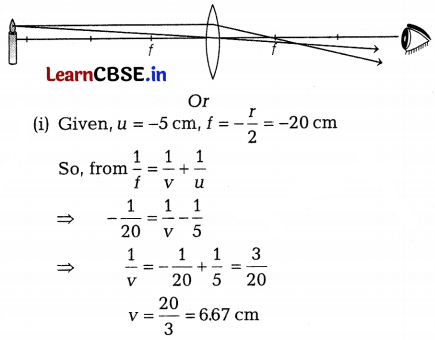
The image is obtained at 6.67 cm behind the mirror.
(ii) According to the formula of magnification,
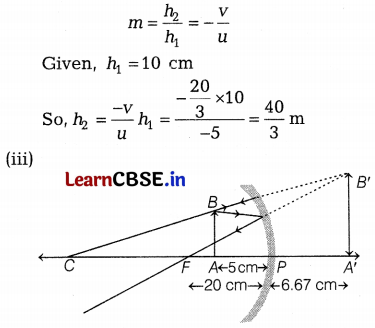
Section-E(12 Marks)
(Q.no. 37 to 39 are case-based/data-based questions with 2 to 3 short sub-parts.)
(Internal choice is provided in one of these sub-parts.)
Question 37.
The table given below shows the hints given by the quiz master in a quiz.
| S.No | HINT |
| (i) | Substance ’C is used as a preservative. |
| (ii) | ‘C has two carbon atoms; ‘C’ is obtained by the reaction of ‘A’ in presence of alkaline Pbtassium permanganate followed by acidification. |
| (iii) | Misuse of ‘A’ in industries is prevented by adding Methanol, Benzene, and pyridine to ‘A’. |
| (iv) | ‘F’ is formed on heating ‘A’ in presence of cone Sulphuric acid. |
| (v) | ‘F’ reacts with Hydrogen gas in presence of Nickel and Palladium catalyst. |
Based on the given hints answer the following questions:
(a) Give the IUPAC names of A and F
(b) Illustrate with the help of chemical equations the changes taking place. (A → C and A → F)
Answer:
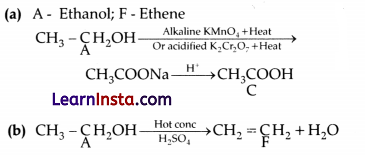
OR
Name the chemical reactions which occur in steps 2 and 5. Identify the compounds formed in these steps if ‘A is replaced with its next homologue.
Answer:
Oxidation, Addition/ Hydrogenation Propanol, Propene.
![]()
Question 38.
Figures (a) to (d) given below represent the type of ear lobes present in a family consisting of 2 children – Rahul, and Nisha and their parents.
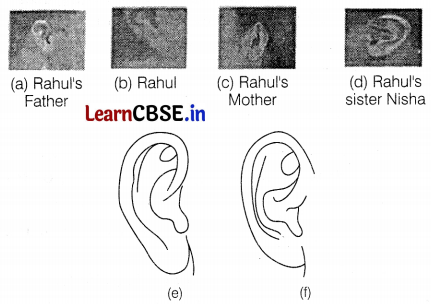
Excited by his observation of different types of ear lobes present in his family, Rahul surveyed the type of ear lobes found [Figs, (e) and (f)] in his classmates. He found two types of ear lobes in his classmates as per the frequency given below.
| Sex | Free | Attached |
| Male | 36 | 14 |
| Female | 31 | 19 |
Based on the above data, answer the following questions.
(i) Which of the two characteristics ‘free ear lobe’ or ‘attached ear lobe’ appears to be dominant in this case? Why?
(ii) Is the inheritance of the free ear lobe linked with the sex of the individual? Give a reason for your answer.
(iii) What type of ear lobe is present in father, mother, Rahul, and his sister Nisha? Write the genetic constitution of each of these family members which explains the inheritance of this character in this family.
(The gene for the free ear lobe is represented by F and the gene for the attached ear lobe is represented by for writing the generic constitution).
Or
Suresh’s parents have attached ear lobes. What type of ear lobe can be seen in Suresh and his sister Siya? Explain by giving the genetic composition of all.
Answer:
(i) The free ear lobe appears to be dominant in this case because a large majority of the population has this type of ear lobe.
(ii) No, it is not sex-linked. As per the data of the family as well as the class, it is observed that the free ear lobe is present in males as well as in females.
(iii)
| Name | Type of Lobe | Genetic Constitution |
| Father | Free ear lobe | Ff |
| Mother | Free ear lobe | Ff |
| Rahul | Attached ear lobe | Ff |
| Nisha | Free ear lobe | Ff |
| Or | ||
| Parents | Attached ear lobe | Ff |
| Suresh | Attached ear lobe | Ff |
| Siya | Attached ear lobe | ff |
If both parents have recessive traits or characters, then all the children will have recessive characters only.